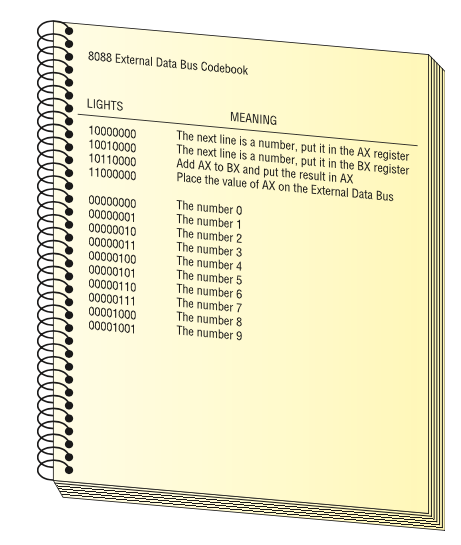Question 1
Perform the following binary additions: 1. 101 + 11 = 2. 111 + 111 = 3. 1010 + 1010 = 4. 11101 + 1010 = 5. 11111 + 11111 =
- 1000
- 1110
- 10100
- 100111
- 111110
Question 2
Convert the following numbers to binary and perform the operation: 1. (32)10 = 2. (50)10 + (32)10 = 3. (64)10 + (4)10 = 4. (100)10 + (220)10 =
- 100000
- 1010010
- 1000100
- 101000000
Question 3
Given the codebook below, write the binary instructions to perform this operation: (100)10 + (220)10 .  - What’s the final value on the External Data Bus?
- What’s the final value on the External Data Bus?
- 1000 0000
- 0110 1110
- 1001 0000
- 1101 1100
- 1011 0000
- 1100 0000
1101110 + 11011100 = 101000000, but since the CPU’s bus size is limited to 8 bits, the most significant bit (left most, or highest power) will be lost. The final answer on the ESD is 01000000 (64).
Question 4
What is -230 in two’s complement represetation with an 12 bits bus width?
- Write 230 in binary: 1 0100 0000
- Complete the number of bits to 12 and add a bit for the sign: __0__0001 0100 0000
- Flip the bits (one’s complement): __1__1110 1011 1111
- Add 1 to get two’s complement: __1__1110 1100 0000
Question 5
Convert the following numbers to binary and perform the operation on an 8-bit CPU: 1. (50)10 - (32)10 = 2. (64)10 - (4)10 = 3. (100)10 - (120)10 =
- (50)10 - (32)10 = (50)10 + (-32)10 Binary 50: 0011 0010 Binary 32: 0010 0000 Invert 32: 1101 1111 Add 1: 1110 0000 Operation: 50-32 : 0011 0010
- (64)10 - (4)10 = (64)10 + (-4)10 Binary 64: 0100 0000 Binary 4: 0000 0100 Invert 4: 1111 1011 Add 1: 1111 1100 Operation 64 - 4: 0100 0000
- Binary 100: 0110 0100 Binary 120: 0111 1000 Invert 120: 1000 0111 Add 1: 1000 1000 Operation: 100 - 120: 0110 0100
Back to top
 - What’s the final value on the External Data Bus?
- What’s the final value on the External Data Bus?